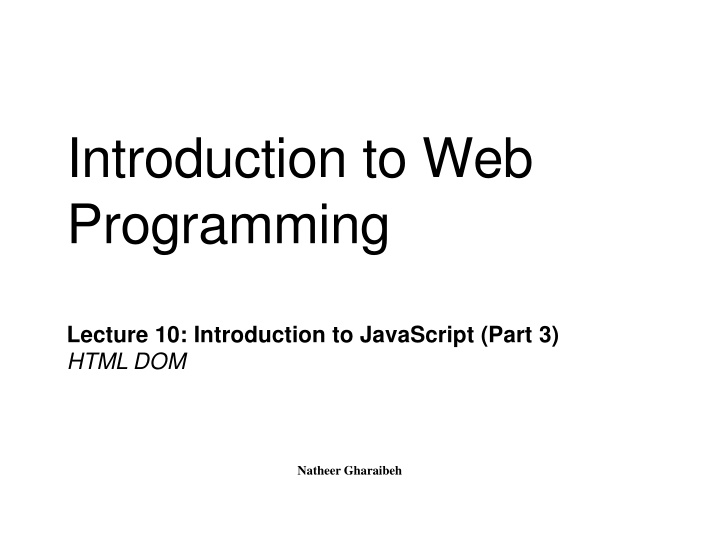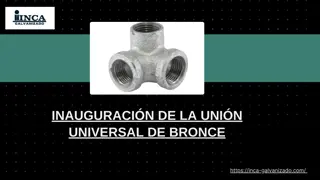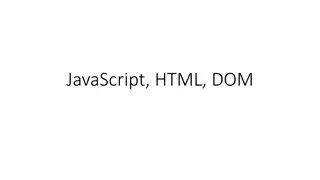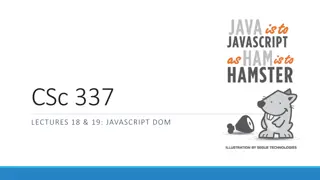
HTML Document Object Model (DOM) Fundamentals
Explore the concept of DOM in web programming, learn how to manipulate HTML elements dynamically, and understand the structure and hierarchy of the Document Object Model. Enhance your knowledge of accessing, updating, and managing content in HTML documents efficiently.
Uploaded on | 3 Views
Download Presentation

Please find below an Image/Link to download the presentation.
The content on the website is provided AS IS for your information and personal use only. It may not be sold, licensed, or shared on other websites without obtaining consent from the author. If you encounter any issues during the download, it is possible that the publisher has removed the file from their server.
You are allowed to download the files provided on this website for personal or commercial use, subject to the condition that they are used lawfully. All files are the property of their respective owners.
The content on the website is provided AS IS for your information and personal use only. It may not be sold, licensed, or shared on other websites without obtaining consent from the author.
E N D
Presentation Transcript
Introduction to Web Programming Lecture 10: Introduction to JavaScript (Part 3) HTML DOM Natheer Gharaibeh
Outlines of todays lecture What s DOM? How to find HTML elements in the document. How to change the content, attributes and style of HTML elements. 2
What is DOM? The DOM defines a standard for accessing documents: "The W3C Document Object Model (DOM) is a platform and language-neutral interface that allows programs and scripts to dynamically access and update the content, structure, and style of a document. When a web page is loaded, the browser creates a Document Object Model (DOM) of the page. The HTML DOM is considered as a tree of objects. 3
What is DOM? (cont.) The Document Object Model, or DOM, is the fundamental API for representing and manipulating the content of HTML documents. It defines: The HTML elements as objects The properties of all HTML elements The methods to access all HTML elements The events for all HTML elements In other words: The HTML DOM is a standard for how to get, change, add, or delete HTMLelements. 4
Overview of the DOM <html> <head> <title>Sample Document</title> </head> <body> <h1>An HTML Document</h1> <p>This is a <i>simple</i> document. </body> </html> 5
How Is It Created? The HTML DOM model is constructed as a tree of Objects: 6
Overview of the DOM (Cont.) The node directly above a node is the parent of thatnode. The nodes one level directly below another node are the children of that node. Nodes at the same level, and with the same parent, are siblings. The set of nodes any number of levels below another node are the descendants of that node. And the parent, grandparent, and all other nodes abovea node are the ancestors of that node. 7
The DOM Document In the HTML DOM object model, the document object represents your web page. The document object is the owner of all other objects in your web page. If you want to access objects in an HTML page, you always start with accessing the document object. 8
The DOM Programming Interface The HTML DOM can be accessed with JavaScript (and withother programming languages). In the DOM, all HTML elements are defined asobjects. The programming interface is the properties and methods of each object. A property is a value that you can get or set (like changingthe content of an HTML element). A method is an action you can do (like adding or deletingan HTML element). 9
The DOM Programming Interface (Cont.) The getElementById Method The most common way to access an HTML element is to use the id of the element. The innerHTML Property The easiest way to get the content of an element is by using the innerHTML property. The innerHTML property is useful for getting or replacing the content of HTML elements. The innerHTML property can be used to get or change anyHTML element, including <html> and <body>. 10
Properties and MethodsExample The following example changes the content (the innerHTML) of the <p> element with id="demo": <html> <body> <p id="demo"></p> <script> document.getElementById("demo").innerHTML = "Hello World!"; </script> </body> </html> In the example above, getElementById is a method, while innerHTML is a property 11
HTML DOM Elements Finding HTML Elements Often, with JavaScript, you want to manipulate HTMLelements. To do so, you have to find the elements first. There are a number of ways to do this, a few are listed as follows: Finding HTML elements by id Finding HTML elements by tag name Finding HTML elements by class name Finding HTML elements by HTML object collections 12
1. Finding HTML Elements by Id Any HTML element can have an idattribute. The value of this attribute must be unique within thedocument no two elements in the same document can have the same ID. The easiest way to find HTML elements in the DOM, is by using the element id. You can select an element based on this unique ID with the getElementById() method of the Document object If the element is found, the method will return the element asan object. If the element is not found, the method will returnnull. 13
1. Finding HTML Elements by Id Example This example finds the element with id= intro": <body> <p id="intro">Hello World!</p> <p>This example demonstrates the <b>getElementById</b> method! </p> <p id="demo"></p> <script> var myElement = document.getElementById("intro"); document.getElementById("demo").innerHTML = "The text from the intro paragraph is " + myElement.innerHTML; </script> </body> 14
2. Finding HTML Elements by Tag Name You can select all HTML elements of a specified type (or tag name) using the getElementsByTagName() method. getElementsByTagName() returns a NodeList object. The nodes in the node list can be accessed throughtheir index number (starting from 0). The elements of the returned NodeList are in document order, so you can select the first <p> element of a document likethis: var firstpara = document.getElementsByTagName("p")[0]; 15
2. Finding HTML Elements by Tag Name Example This example finds the element with id="main", and then finds all <p> elements inside "main": <div id="main"> <p>The DOM is very useful.</p> <p>This example demonstrates the <b>getElementsByTagName</b> method</p> </div> <p id="demo"></p> <script> var x = document.getElementById("main"); var y = x.getElementsByTagName("p"); document.getElementById("demo").innerHTML = 'The first paragraph inside "main" is ' + y[0].innerHTML; </script> 16
3. Finding HTML Elements by Class Name You can select all HTML elements of a specified class using the getElementsByClassName() method. It returns a live NodeList containing all matching descendants of the document or element. 17
4. Finding HTML Elements by HTML Object Collections The Document Object Model contains several collections,which are groups of related objects on a page. DOM collections are accessed as properties of DOMobjects such as the document object or a DOM node. The document object has properties containing the images collection links collection forms collection anchors collection These collections contain all the elements of the corresponding type on the page. 18
4. Finding HTML Elements by HTML Object Collections Example <html> <body> <a name= html >HTML Tutorial</a><br> <a name="css">CSSTutorial</a><br> <a name="xml">XMLTutorial</a><br> <p id="demo"></p> <script> document.getElementById("demo").innerHTML = "The content of the first anchor is: " + document.anchors[0].innerHTML; </script> </body> </html> 19
Changing HTML Content The easiest way to modify the content of an HTML element is by using the innerHTML property. Write the script that will change the content of the <p> element to Good Morning! <html> <body> <p id="p1">Hello World!</p> <script> ? </script> </body> </html> 20
Changing the Value of an Attribute To change the value of an HTML attribute, use this syntax: document.getElementById(id).attribute=new value Write a script that changes the value of the src attribute of the <img> element to image1.gif : <!DOCTYPE html> <html> <body> <img id="myImage" src="smiley.gif"> <script> ? </script> </body> </html> 21
Changing HTML Style To change the style of an HTML element, use this syntax: document.getElementById(id).style.property=new style Write a script that changes the text color of the <p> element <html> <body> <p id="p2">HelloWorld!</p> <script> </script> <p>The paragraph above was changed by ascript.</p> </body> </html> 22
References www.w3schools.com Flanagan, David. JavaScript: The definitive guide: Activateyour web pages. O'Reilly Media, Inc., 2011. Deitel & Deitel (2011). Internet and World Wide Web How to Program, 5th Edition, Harvey & Paul Deitel &Associates. 23






















